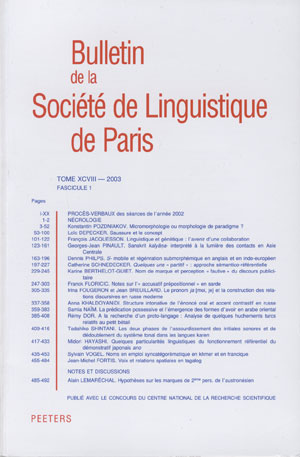 previous article in this issue previous article in this issue | next article in this issue  |

Preview first page |
Document Details : Title: Chinois dōu Author(s): LEMARÉCHAL, Alain , XIAO, Lin Journal: Bulletin de la Société de Linguistique de Paris Volume: 115 Issue: 1 Date: 2020 Pages: 467-501 DOI: 10.2143/BSL.115.1.3289166 Abstract : Le chinois dōu «tout» a, dans les dernières décennies, fait couler beaucoup d’encre; on a voulu y voir un «quantificateur flottant», assez curieusement puisque dōu n’en a aucune des caractéristiques, et qu’entre autres, il occupe une position strictement fixe dans la séquence, à condition de calculer celle-ci à partir du prédicat. Par ailleurs, dōu est presque invariablement considéré comme un adverbe modifiant le prédicat qui le suit. Nous proposons d’en faire un pronom. Une des caractéristiques de dōu qui ont le plus attiré l’attention est que l’entité ou l’ensemble d’entités dont il exprime la quantification ne puissent être mentionnés qu’avant lui, dōu ne porte jamais sur ce qui le suit. Il peut renvoyer au sujet, ou à l’objet à condition que celui-ci soit topicalisé. Il y a de bonnes raisons de penser que le constituant auquel renvoie dōu et qui lui est antéposé dans la même phrase est toujours un élément topicalisé quelle que soit la fonction de cet élément, sujet, objet ou circonstant. Nous proposons de faire de dōu un «pronom de rappel» («résomptif») qui reprend, dans la partie focale du noyau propositionnel, un constituant détaché dans la partie topicale de la phrase. L’apparente «déplaçabilité» de dōu dans les phrases mettant en oeuvre la «construction de l’objet antéposé avec bă» (< S + bă + O + V >) ou bien «le passif périphrastique en bèi» (< Patient + bèi + Agent + V >) est un leurre. Pour peu qu’on adopte les analyses que nous avons proposées dans le BSL 112/1 (2017), qui font de bă et de bèi des verbes qui, bien que grammaticalisés, ont gardé une partie de leur statut de verbes, on rendra compte, sans détours inutiles, de la position de dōu, avant vs après bă, avant vs après bèi: dōu occupe la même position que dans ses autres emplois: devant le prédicat – en l’occurrence devant bă, devant bèi, ou devant le verbe plein –, et renvoie ici au sujet de ces prédicats. Nous aborderons ensuite deux autres emplois de dōu, où l’on a quelque difficulté à reconnaître un «tout»: 1) son emploi dans lián X dōu (avec lián «inclure, inclus» > «même») et X dōu (sans lián), et 2) un emploi dit «modal» («énonciatif» serait préférable), où dōu est, à la différence de tous ces autres emplois, inaccentué, type de phénomènes auxquels des auteurs pourtant déjà anciens comme Chao et Alleton portaient souvent meilleure attention que les linguistes d’aujourd’hui: dōu fonctionne ici comme un «c’est tout» prédiqué de l’énonciation. Nous traiterons ces deux emplois en termes de «constructions compactées». En appendice, nous reviendrons sur l’origine de dōu: un verbe «(se) rassembler» qui passe à une valeur «pris dans son ensemble, tout» moyennant un changement de structures syntaxique et énonciative. Much has been written about Chinese dōu 'everything' or 'everyone' in the past decades. It has been considered a ‘floating quantifier’, oddly enough since dōu has none of the characteristics of ‘floating quantifiers’, and in particular since it occupies a strictly fixed position in the sequence, provided that position is calculated from the predicate. Besides, dōu is almost invariably considered to be an adverb modifying the predicate which follows it. We suggest considering it a pronoun. One of the features of dōu that has attracted most of the attention is that the entity or set of entities whose quantification it expresses can only be mentioned before it, dōu never refers to what follows. It can refer to the subject, or to the object provided that it is topicalized. There are good reasons to think that the constituent to which dōu refers and which is anteposed to it in the same sentence is always a topical element whatever the function of this element, subject, object or circumstance. We will propose to consider dōu a ‘resumptive pronoun’ which takes up, in the focal part of the propositional nucleus, a constituent detached in the topical part of the sentence. The apparent ‘displaceability’ of dōu in the sentences implementing the ‘construction of the anteposed object with bǎ’ (< S + bǎ + O + V >) or ‘the periphrastic passive with bèi’ (< Patient + bèi + Agent + V >) is an illusion. If following the analyzes we put forward in BSL 112/1 (2017), where we consider bǎ and bèi to be verbs which, although grammaticalized, have kept part of their status and syntactic behaviour as verbs, we will conclude, without unnecessary detours, that the position of dōu, before vs after bǎ, before vs after bèi is the same as in its other uses, that is to say before the predicate, in this case before bǎ, before bèi, or before the full verb, and refers to the subject of these predicates. We will then discuss two other uses of dōu, where it is somewhat difficult to identify a word meaning 'all': 1) its use in lián X dōu (with lián 'include, included' > 'even') and X dōu (without lián), and 2) a use called ‘modal’ (or rather ‘enunciative’), where dōu is, unlike all its other uses, unaccented, a type of phenomena to which Alleton paid the greatest attention but which linguists nowadays almost completely neglect. Dōu functions here as a 'that’s all' predicated of the utterance. We will treat these two uses in terms of 'compacted constructions'. At the end, we go back to the question of the origins of dōu: a verb meaning 'to gather' which through a change in its syntactic construction became a 'in one’s entirety, as a whole'. |
|


